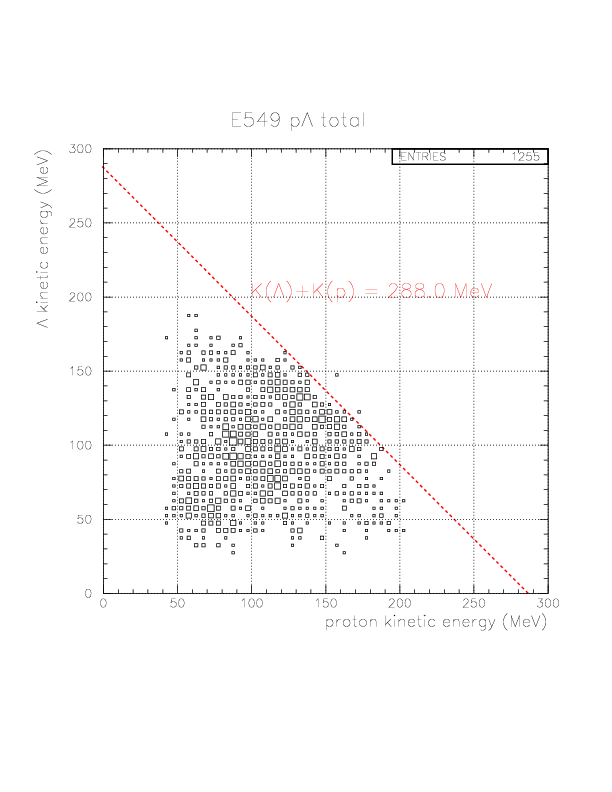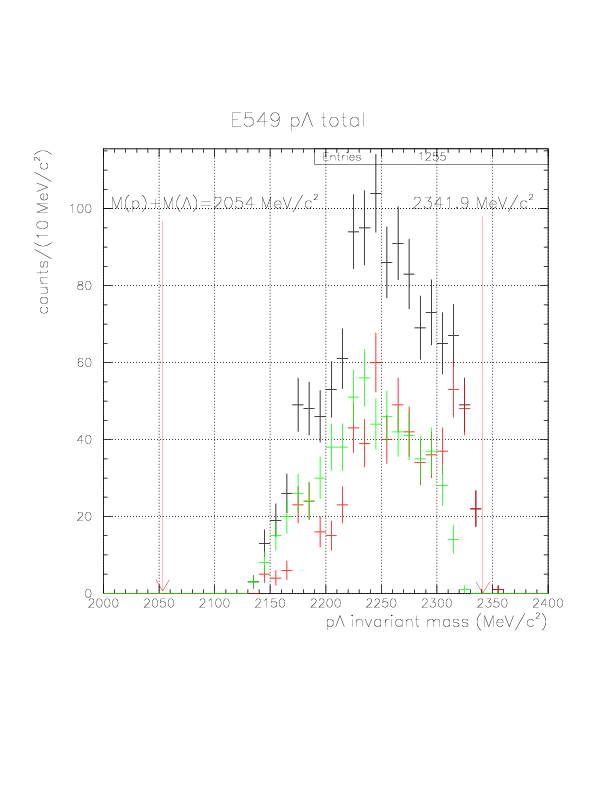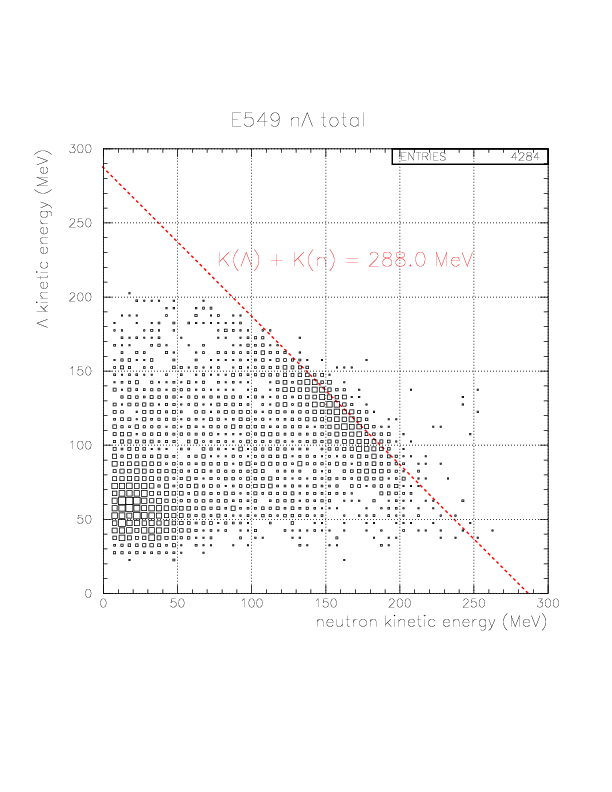Until now, we had some ambiguities on &pi detection on TC, as listed below:
1. Re-define the reaction vertex with proton/&pi tracks. Then, proton/&pi vertex is more accurately given for &Lambda->p&pi events. This is extremely important, because the procedure 2 does not work correctly, otherwise.
2. Re-define proton TOF from its generation to PA arrival by energy-loss correction, by newly-defined p&pi vertex, and perform PA-TC TOF measurement for &pi. Or, calculate TOF distance of &Lambda and get TOF(&Lambda) directly assuming p&pi pair is from &Lambda decay (Then, &Lambda momentum and decay vertex are known, hence TOF distance can be calculated as the distance between decay vertex and reaction vertex which can be defined as the closest approaching point of kaon track and a strainght line defined by &Lambda momentum and decay vertex). The two alternative ways are illustrated below.
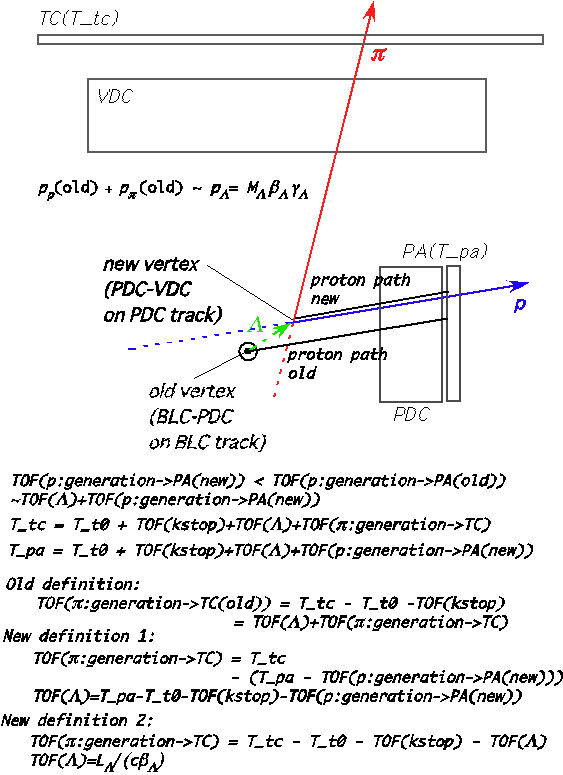
3. Estimate initial momentum of &pi by energy-loss correction procedure as for proton, with the reaction vertex and re-calculated TOF.
Then, we expect some improvements on the &Lambda central mass and width on the p&pi invariant mass spectra. Note that this analysis properly works ONLY IF p&pi pair is from &Lambda decay, and if the p/&pi pair is NOT from &Lambda decay, it introduces certain systematics on the p/&pi momentum. Therefore, we adopt this analysis ONLY for n&Lambda/p&Lambda invariant mass construction.
As shown below for p&Lambda events, x-motion of &Lambda is very clearly seen in the comparison of K^--p(Rarm)/&pi--p(&Lambda decay) vertices. For n&Lambda events, K-p/&pi-p pair is unique, hence we do not need to care about that issue.
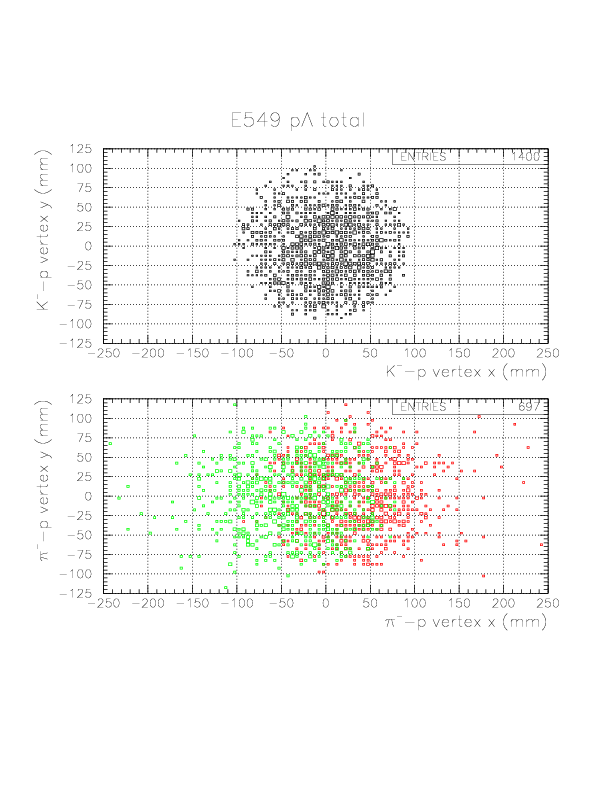


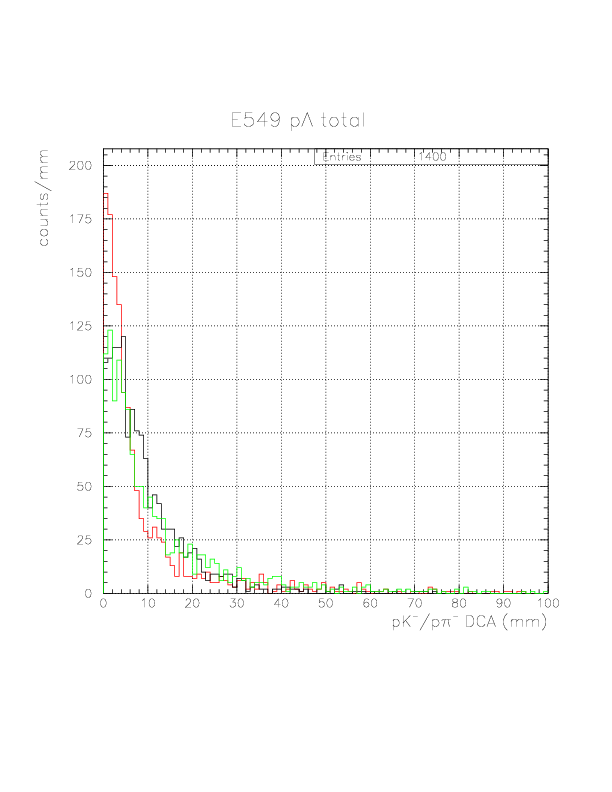
TOF(&Lambda) = T_pa - T_t0 - TOFkstop(z) - TOF(p:generation->PA | new).
Then,TOF(&pi:generation->TC) = T_tc - T_t0 - TOFkstop(z) - TOF(&Lambda)
= T_tc - (T_pa - TOF(p:generation->PA | new))
Therefore, we re-try energy loss correction for pp/pn + &pi on TC events (only for decay proton in pp case, while proton is unique for pn case), and investigate it. It should be noted that the procedure also affect corrected proton momentum, and over-corrected momentum of protons from &Lambda decay tends to shift smaller. On this method, we re-calculate the proton momentum 3-vector by new vertex.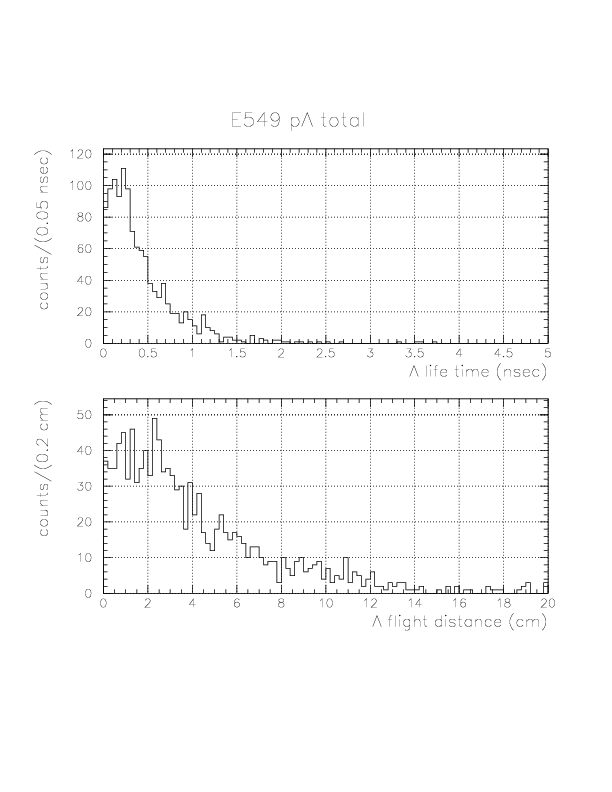
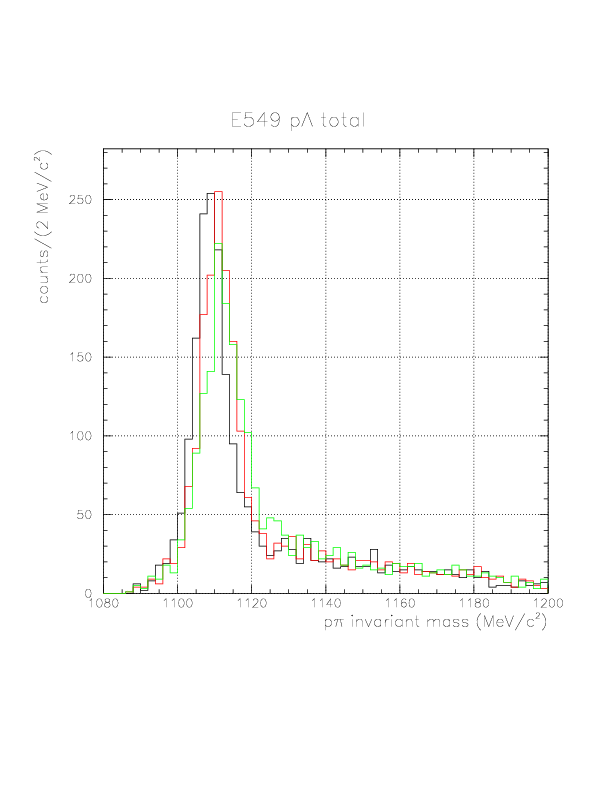
TOF(&Lambda) = L_&Lambda /(c * &beta_&Lambda).
Here, L_&Lambda is directly calculated from momentum 3-vector of &Lambda, and &beta_&Lambda is also calculated from the vector sum of pion/proton 3-momenta. By using TOF(&Lambda) in the definition, &pi TOF is re-calculated byTOF(&pi:generation->TC) = T_tc - T_t0 - TOFkstop(z) - TOF(&Lambda),
and &pi momentum is defined again. The distribution of TOF(&Lambda), and updated p&pi invariant mass spectrum are shown below. On this method, we re-calculate the proton momentum 3-vector also by new vertex.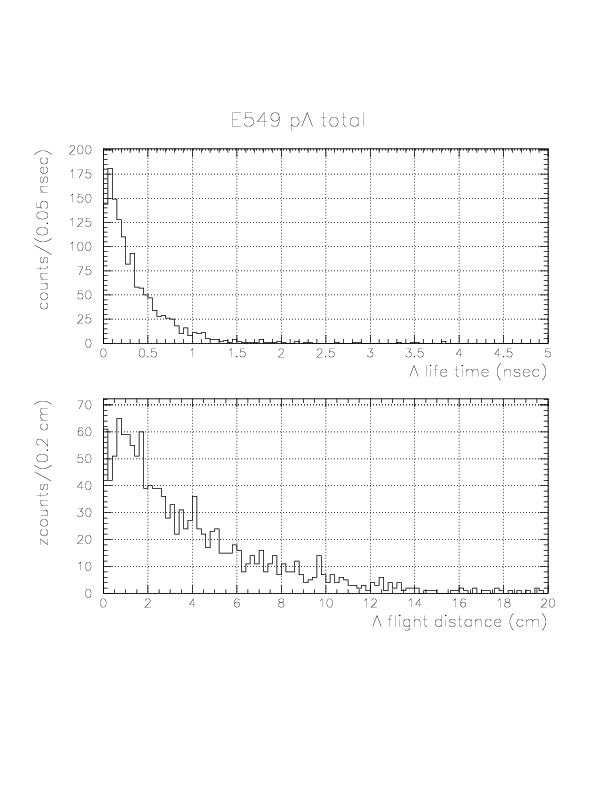
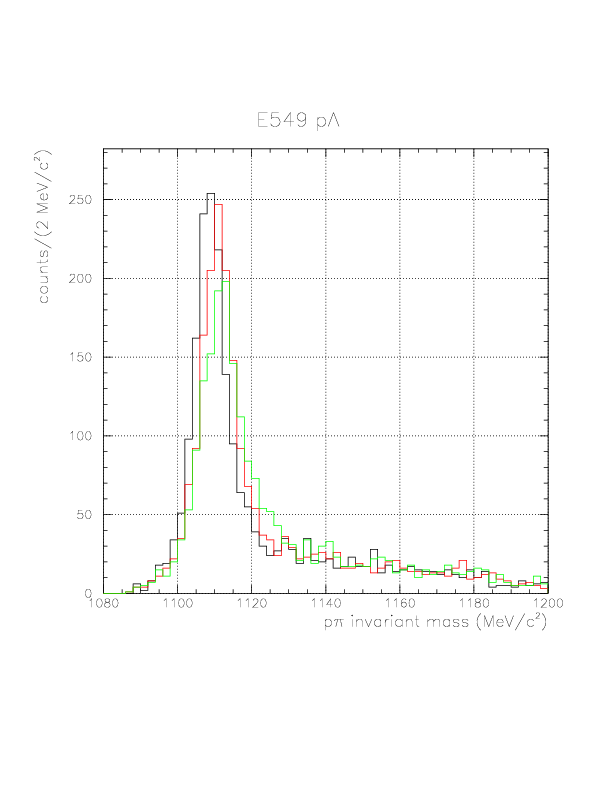
The best results from method 1/2 are now directly compared. The result from method 1 looks slightly better and we adopt it.

1. Primary proton and decay proton energy corrections are successfully done simultaneously. 2224 out of 2377 events survive the selection.
2. pion 1/&beta is larger than 1.0 AFTER the &Lambda life-time correction. 2178 out of 2224 survive the selection.
We apply the &pi energy correction for the 2178 events. The energy loss correction has not been successfully done for 48 events, because of the TC-VDC inconsistency (4 events: the pion cannot fire TC if it just goes ahead according to the detected VDC track) and vertex-TOF inconsistency (44 events:no consistent initial momentum exist). Therefore, we have obtained 2130 pp+&pi on TC events, to which corrections for p/&pi energy loss/&Lambda life time had been successfully done. The resulting p&pi invariant mass spectrum is shown below. The peak center is shifted around 1115 MeV/c2, and we obtained 1217 p&Lambda events in which about (~20counts/bin*8bins=)~160 conbinatorial background from &Lambda identification is included, identifying &Lambda when p&pi invariant mass value within (1108.0,1124.0).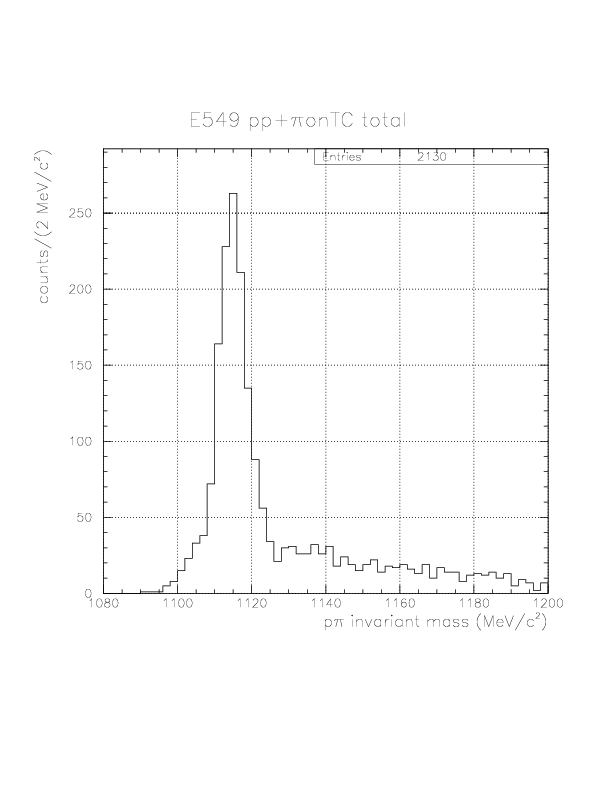
1. Decay proton energy correction is successfully done, hence &Lambda life time is well-defined. 13058 out of 13488 events survive the selection.
2. pion 1/&beta is larger than 1.0 AFTER the &Lambda life-time correction. 12820 out of 13058 events survive the selection.
We apply the &pi energy correction for the 12820 events. The energy loss correction has not been successfully done for 407 events, because of the TC-VDC inconsistency (65 events: the pion cannot fire TC if it just goes ahead along with the detected VDC track), vertex-TOF inconsistency (342 events:no consistent initial momentum exist) and . Therefore, we have obtained 12413 pn+&pi on TC events, to which corrections for p/&pi energy loss/&Lambda life time had been successfully done. The resulting p&pi invariant mass spectrum is shown below. The peak center is shifted around 1115 MeV/c2, and we obtained 4284 n&Lambda events in which about (100 counts/bin*8bins=)800 conbinatorial background from &Lambda identification is included, identifying &Lambda when p&pi invariant mass value within (1108.0,1124.0).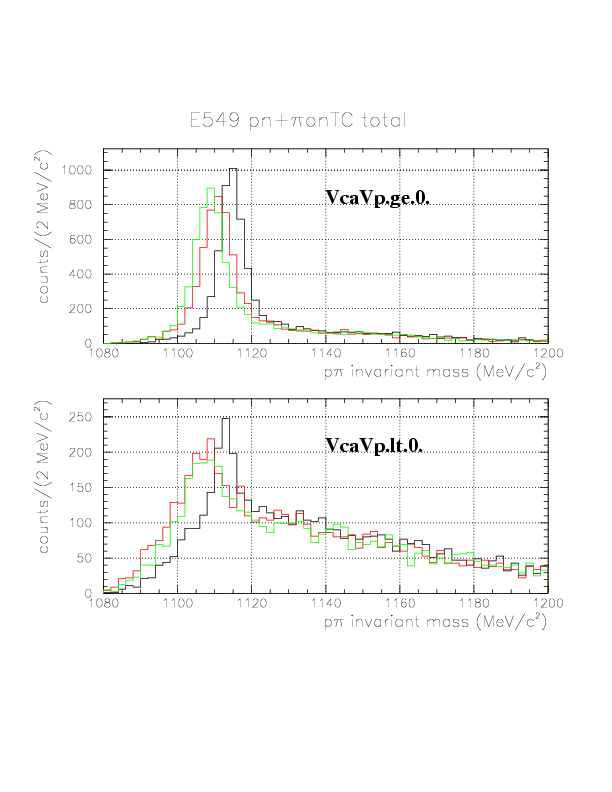
p&Lambda side
M(K-) + M(p) + M(p) -B.E.(4He) = E(&Lambda) + E(p)
->M(K-) + M(p) - M(&Lambda) -B.E.(4He) = K(&Lambda) + K(p)
n&Lambda side:M(K-) + M(p) + M(n) - B.E.(4He) + M(p) + M(n) = E(&Lambda) + E(n) + M(p) + M(n)
orM(K-) + M(p) + M(n) - B.E.(4He) + M(p) + M(n) = E(&Lambda) + E(n) + M(d)
->M(K-) + M(p) - M(&Lambda) - B.E.(4He) = K(&Lambda) + K(n)
orM(K-) + M(p) - M(&Lambda) - B.E.(4He) + B.E.(d) = K(&Lambda) + K(n)
The updated N&Lambda invariant mass spectra and K(N)-K(&Lambda) correlation are shown below.